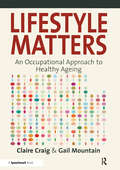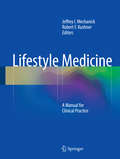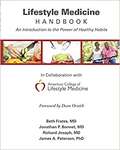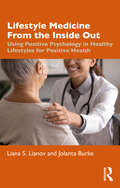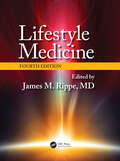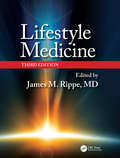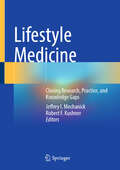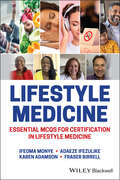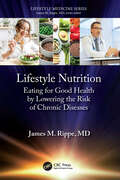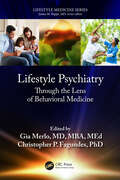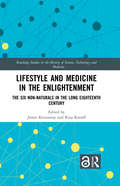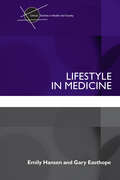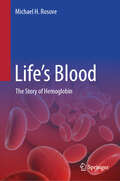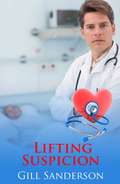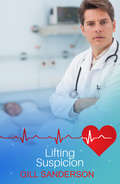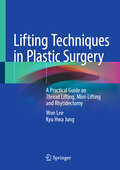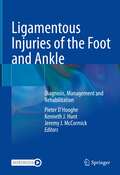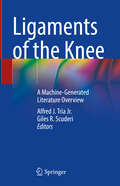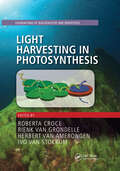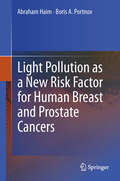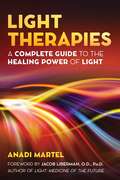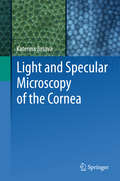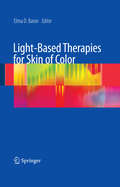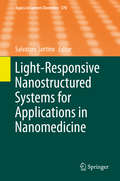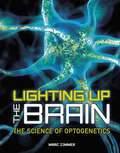- Table View
- List View
Lifestyle Matters: An Occupational Approach to Healthy Ageing
by Claire Craig Gail Mountain"Lifestyle Matters" is a practical resource that contains a wealth of ideas and activities for occupational therapists, support workers, students and other professionals working with older people in the community. Taking a holistic approach, the Lifestyle Matters programme challenges participants to examine their lifestyle and to make positive changes which promote good physical and emotional health. Themes include: "'The relationship between activity and health " Maintaining mental well-being'; 'Maintaining physical well-being'; Safety in the home and community'; and, Personal circumstances. Each theme is divided into a number of sessions with ideas for introductory activities, group discussion topics and group activity ideas. There are also 64 photocopiable handouts in the book and on the downloadable resources that can be used within the group sessions. The book is divided into four parts: 'The Lifestyle Matters programme and the principles behind it'; 'How to implement the programme - including who can benefit from it, how long it should last and the resources required'; 'Delivering the programme - looking at session structure, selecting a session and keeping a record of group and individual sessions'; and, 'The Lifestyle Matters manual - each section containing a combination of group sessions, individual sessions and visits or outings'. Inspired by research by Florence Clark and her colleagues at the University of Southern California, this Lifestyle Matters programme has been developed through consultation with older people at every stage, making it a welcome and invaluable resource. As one member of a group exclaimed, 'You didn't give me a new lease of life, you gave me back my life!'. "Lifestyle Matters" is now referred to in the NICE guidelines (2009) where it is identified as the intervention of choice for therapists and professionals responding to the guidance by this professional body.
Lifestyle Medicine
by Robert F. Kushner Jeffrey I. MechanickLifestyle - the manner in which people live - is fundamental to health, wellness, and prevention of disease. It follows that attention to lifestyle is critically important to effective and successful health care. But here's the challenge: health care professionals receive very little, if any, formal training about lifestyle counseling and therefore are ill equipped to incorporate lifestyle issues into clinical practice. In response, "Lifestyle Medicine" is evolving as a means to fill this knowledge gap. Lifestyle medicine approaches health and wellness by harnessing the power of lifestyle-related behaviors and influencing the environment we live in. It is a formal approach that promises to enhance and strengthen a re-invigorated health care system that is still outpaced by the epidemic proportions and complexity of chronic diseases like obesity, diabetes, depression, hypertension, and cancer, among others. Lifestyle Medicine: A Manual for Clinical Practice presents this formal approach in a pragmatic context. This unique and practical manual provides clear and succinct guidance on nearly all aspects of lifestyle medicine. The approach is both explanatory and pragmatic, providing case studies and bulleted translation of academic information into clinical practice recommendations. There is an emphasis on scientific evidence wherever possible as well as opinions by the expert chapter authors who practice lifestyle medicine. There is a "how-to" rationality to the book, consistent with a premise that any and all health care professionals should, and perhaps must, incorporate lifestyle medicine. A valuable checklist is included at the close of the book that summarizes key points and provides a practical tool for routine patient encounters.
Lifestyle Medicine Handbook: An Introduction To The Power Of Healthy Habits
by Beth FratesThe Lifestyle Medicine Handbook: An Introduction to the Power of Healthy Habits is a well-researched and practical resource for anyone who wants to know more about the field of lifestyle medicine. Blending lifestyle medicine knowledge with clinical examples, this cutting-edge book offers a comprehensive overview of the eight pillars of lifestyle medicine. Published in collaboration with the American College of Lifestyle Medicine, this handbook is designed to introduce individuals and practitioners at all levels to the importance of daily habits and actions in health and quality of life.
Lifestyle Medicine from the Inside Out: Using Positive Psychology in Healthy Lifestyles for Positive Health
by Jolanta Burke Liana S. LianovLifestyle Medicine From the Inside Out: Using Positive Psychology in Healthy Lifestyles for Positive Health summarizes the principles, science, and practice of how positive psychology can be integrated into lifestyle medicine for positive health in health care and self-care. This integration builds physical health and well-being, buffers against adversity, and promotes personal growth after traumatic experiences. By intertwining healthy habits and positive psychology-based activities, including personal strengths and what is meaningful to each person, individuals can truly thrive. Such an approach is what the authors refer to as practicing "lifestyle medicine from the inside out."Co-authored by the lead developer of the original lifestyle medicine competencies, this book suggests positive health expansions for each competency, outlines specific questions that drive personal reflection for change and positive clinical interactions, and describes the step-by-step approach in case studies. Such innovative clinical practice that connects with what matters most to individuals is foundational to care.In a rapidly changing and increasingly challenging world, health professionals in a wide variety of roles practicing in lifestyle medicine, primary care, and across medical specialties, patients, and all individuals can benefit from the insights and practical tips outlined in this book to achieve and maintain flourishing.
Lifestyle Medicine, Fourth Edition (Lifestyle Medicine Ser.)
by James M. RippeThe fourth edition of Dr. James Rippe’s classic Lifestyle Medicine textbook continues to lead and inform the rapidly growing field of lifestyle medicine. This is the discipline that focuses on the impact of daily habits and actions on both short- and long-term health and quality of life.The first edition of this comprehensive work named the field of lifestyle medicine in the academic medical literature. The fourth edition continues to span and expand the field and offers extensive evidence-based literature in virtually every aspect of lifestyle medicine. This Textbook, edited by cardiologist Dr. James Rippe, who is a leading lifestyle medicine researcher, represents the combined wisdom and recommendations of over 325 experts in virtually every aspect of lifestyle medicine. Chapter authors have been chosen because of their background as leaders in various aspects of lifestyle medicine.Lifestyle Medicine, Fourth Edition contains extensive sections on the treatment and prevention of coronary heart disease,stroke, cancer, diabetes, obesity, substance abuse, dementia, and many other clinical conditions. Key lifestyle modalities such as physical activity, nutrition, weight management, sleep, stress reduction, and positive connections with other humans are supported by detailed discussion and state-of-the-art evidence. The expanded section on behavioral medicine provides an important framework for these discussions. Every chapter has been completely revised and many new topics added, such as lifestyle medicine for nursing, psychiatry, and preventive neurology.The fourth edition of this classic text continues to serve as the leading, comprehensive textbook in lifestyle medicine. The original has been called the “indispensable bible” of lifestyle medicine, and the fourth edition of this work continues to justify this designation.There is no longer any serious doubt that daily habits and actions have a significant impact on multiple aspects of health. The fourth edition of Lifestyle Medicine provides the scientific evidence to support this assertion and will serve as an invaluable reference and guide, not only to lifestyle medicine practitioners but to all primary care physicians, subspecialty physicians, nurses, and other healthcare practitioners.
Lifestyle Medicine, Third Edition (Lifestyle Medicine Ser.)
by James M. RippeThe field of lifestyle medicine, which is the study of how daily habits and actions impact on both short- and long-term health and quality of life, continues to expand globally. The scientific and medical literature that supports the success of these lifestyle habits and actions is now overwhelming. Thousands of studies provide evidence that regular physical activity, maintenance of a health body weight, following sound nutritional practices, stress reduction, and other good practices all profoundly impact both health and quality of life. Following its predecessors, Lifestyle Medicine, Third Edition, is edited by lifestyle medicine pioneer, cardiologist Dr. James Rippe. This edition has been thoroughly updated and represents the expert opinions of 20 section editors as well as more than 150 expert chapter authors whose knowledge span all aspects of this emerging discipline. Topics cover lifestyle medicine practices including regular physical activity, proper nutrition, and weight management. These principles are applied to the prevention and or treatment of a wide variety of chronic conditions ranging from heart disease and diabetes to cancer, mental health, addiction, and injury prevention. This book serves as evidence base for individuals who wish to practice lifestyle medicine or incorporate some of its principles into either general medicine or subspecialty practice. It provides valuable information to healthcare workers in the fields of nutrition, exercise physiology, psychology, behavioral medicine, health promotion, and public policy where lifestyle medicine principles play an ever-increasing role.
Lifestyle Medicine: Closing Research, Practice, and Knowledge Gaps
by Robert F. Kushner Jeffrey I. MechanickThis book represents the third in a series of Springer textbooks on Lifestyle Medicine by Dr. Mechanick and Dr. Kushner. The first book focused on theory and practice concepts. The second book focused on implementation with a specific tactic of building a lifestyle medicine center. This third book focuses on scientific evidence to close research gaps, knowledge gaps, and practice gaps. The general intent is to imbue the field of lifestyle medicine with scientific evidence. The other intent is to continue advancing a culture of preventive care for chronic disease using lifestyle medicine, but again through a tactic of emphasizing science, evidence, and critical thinking. Lifestyle Medicine: Closing Research, Practice, and Knowledge Gaps is organized into three sections. In the first section, driver-based chronic disease models and other elements that pertain to lifestyle medicine are explored in terms of current levels of scientific substantiation. In the second section, educational modalities are presented that can improve awareness of scientific and experiential knowledge by healthcare professionals. Topics include innovative teaching models, web-based activities, training and accreditation programs, and certification exams. In the third section, a variety of clinical scenarios are presented to highlight practice gaps – implementation issues where there is inadequate clinical action despite an awareness of the pertinent knowledge. The topics span critical domains that must be addressed so that lifestyle medicine can lead to favorable outcomes in people and populations at risk. These domains include: alcohol and substance abuse, colitis, brain health, environmental risk, pharmacotherapy de-escalation, routine change, socioeconomics, transculturalization, advanced analytics, home cardiac rehabilitation, digital twin technology, and a highly referenced discussion of the lifestyle medicine ecosystem and infrastructure. Care is taken to provide not only theoretical foundations but also case studies, where appropriate, to emphasize critical aspects. In conclusion, this third book on Lifestyle Medicine will complement the previous two Springer books and define a compendium of resources necessary for anyone interested in this field.
Lifestyle Medicine: Essential MCQs for Certification in Lifestyle Medicine
by Ifeoma Monye Adaeze Ifezulike Karen Adamson Fraser BirrellLIFESTYLE MEDICINE Written by an interdisciplinary and multinational team of distinguished medical doctors and authors, Lifestyle Medicine presents a collection of multiple-choice questions (MCQs) designed to help prepare a new generation of clinicians with the necessary knowledge to practice lifestyle medicine safely and confidently. Ideal for anyone preparing for examinations in the new specialty of lifestyle medicine at the postgraduate level, and especially useful for those studying for the Diploma in Lifestyle Medicine, taking the American Board of Lifestyle Medicine or International Board of Lifestyle Medicine exams, you???ll find every key aspect of lifestyle ??medicine in this book. 25 questions covering an introduction to lifestyle medicine, including definitions, the difference between lifestyle medicine and other fields, and Physician’s Competencies in the practice of lifestyle medicine 62 questions covering the fundamentals of health behaviour change 47 questions covering key clinical processes in lifestyle medicine, including the classification of different lifestyle-related illnesses, measures of fitness, and fitness testing options 88 questions covering nutrition science, assessment, and prescription, including food labels and prescribing nutrition And much, much more: a total of 531 questions covering all key aspects of lifestyle medicine Perfect for clinicians in virtually any specialty aiming to develop expertise in lifestyle medicine, Lifestyle Medicine will also earn a place on the shelves of nurses and other allied health professionals, including pharmacists, dietitians and nutritionists, health educators, researchers, health coaches, and occupational therapists.
Lifestyle Nutrition: Eating for Good Health by Lowering the Risk of Chronic Diseases (Lifestyle Medicine)
by James M. RippeWhat individuals consume in their diet has profound implications on their health. Despite overwhelming evidence that plant-based diets yield multiple health benefits, physicians often feel ill-prepared to discuss nutrition with their patients. Authored by renowned cardiologist Dr. James M. Rippe, Lifestyle Nutrition: Eating for Good Health by Lowering the Risk of Chronic Diseases provides physicians with an evidence-based introduction to nutrition science with a practical emphasis on how to apply this information to improve the health of their patients and enhance their own lives.From nutrition and atherosclerosis to erectile dysfunction and chronic kidney disease to osteoporosis, this comprehensive guide covers a wide range of conditions influenced by diet. It delves into specialized areas, such as nutrition for physically active people to the elderly, ensuring relevance for diverse patient populations. The reader will find detailed analysis of the Dietary Guidelines for Americans 2020–2025 and their applications and strategies for adopting healthy plant-based diets, such as Mediterranean, DASH, and vegan.Each chapter begins with key points and concludes with clinical applications, making it valuable to clinicians. As part of the esteemed Lifestyle Medicine Series, this is an indispensable resource for any healthcare provider committed to enhancing patient care through informed dietary practices.
Lifestyle Psychiatry: Through the Lens of Behavioral Medicine (Lifestyle Medicine)
by Gia Merlo Christopher P. FagundesLifestyle medicine is a practice which adopts evidence-based lifestyle interventions as a primary modality to prevent, treat, and reverse chronic diseases. The six main pillars of this specialty include physical activity, nutrition, stress resilience, cessation or risk reduction of substance use, quality sleep, and connectivity. Lifestyle Psychiatry: Through the Lens of Behavioral Medicine is grounded in the same pillars, drawing upon theories, methods, and empirical findings from health psychology and behavioral medicine. Lifestyle psychiatry is a rapidly emerging area within healthcare informed by rigorous research within the social and biological sciences, public health, and medicine. A volume in the Lifestyle Medicine series, this book uses a comprehensive biopsychosocial approach to prevent and treat psychiatric disorders and promote mental and physical well-being through evidence-based lifestyle interventions. Features: Draws upon theories, methods, and empirical findings from health psychology and behavioral medicine. Provides evidence-based research on the bi-directionality of mental and physical health. Addresses fundamental neuroscience concepts and applies them to practical aspects of lifestyle practices, mental health, and brain health. Appropriate for clinicians, primary care physicians, and those practicing in specialized areas, the information in this book provides users with practical tools to help explain, prevent, and treat psychiatric disorders and associated maladaptive health behaviors in patients.
Lifestyle and Medicine in the Enlightenment: The Six Non-Naturals in the Long Eighteenth Century (Routledge Studies in the History of Science, Technology and Medicine)
by James Kennaway Rina KnoeffThe biggest challenges in public health today are often related to attitudes, diet and exercise. In many ways, this marks a return to the state of medicine in the eighteenth century, when ideals of healthy living were a much more central part of the European consciousness than they have become since the advent of modern clinical medicine. Enlightenment advice on healthy lifestyle was often still discussed in terms of the six non-naturals – airs and places, food and drink, exercise, excretion and retention, and sleep and emotions. This volume examines what it meant to live healthily in the Enlightenment in the context of those non-naturals, showing both the profound continuities from Antiquity and the impact of newer conceptions of the body.
Lifestyle in Medicine (Critical Studies in Health and Society)
by Gary Easthope Emily HansenIn Western societies, 'lifestyle' as an explanation for health and illness has become increasingly popular. Lifestyle in Medicine explores the ambiguity of the term 'lifestyle' and the way it is conceived and applied within medicine. Based on real doctor-patient consultations and in-depth interviews with doctors, the book discusses: the history behind current medical use of lifestyle the variable usage of the 'lifestyle' concept in different medical settings critical writings and recent shifts in sociological thinking about lifestyle public and government concerns about unhealthy lifestyles the ways in which health is discussed, doctor to patient. Evidence-based in its approach, this book uses original research to highlight this topical issue and provides professional and lay perspectives on health and illness. It is essential reading for students and academics of medical sociology, health and allied health studies and anyone interested in health and society.
Life’s Blood: The Story of Hemoglobin
by Michael H. RosoveLife’s Blood: The Story of Hemoglobin encompasses the entire clinically relevant story of hemoglobin, the only molecule we have that captures oxygen from the air we breathe and delivers it to our tissues to generate the energy without which we would not exist. Dr. Rosove covers first the discoveries of oxygen, hemoglobin, and circulation of the blood, then the structure and function of human hemoglobin, together with comparisons to other oxygen transporters in the animal kingdom. He examines the red blood cell and how it protects hemoglobin, with an in-depth look at malaria and the hemoglobin and red cell mutations malaria forced us to make defending ourselves against it, particularly sickle cell disease and the thalassemias. The author also explores adaptations to the oxygen-poor environment of high altitude; lessons from freak hemoglobin mutations; hemoglobin toxins including carbon monoxide and chemicals and drugs that cause oxidant damage; and the quest for a hemoglobin substitute. Life’s Blood is a comprehensive resource for physicians, nurses, and other health professionals, at any and every stage of career development. Even seasoned hematologists, internists, and hospitalists will find something new and informative on practically every page. The book’s approachable, engaging style will also appeal to science-minded readers who will appreciate being awakened to the workings of hemoglobin, a miraculous molecule.
Lifting Suspicion
by Gill SandersonAll Dr. Megan Taylor wants is to carry on with her work as a SHO in the Obs and Gyne department of her hospital. She knows that on occasion people take advantage of her good nature, but she can cope with it. Then her happy world seems to be about to collapse when her former consultant is accused of a crime he cannot defend himself against, and Megan is named as his conspirator. New consultant Christian Firth is her complete opposite - while she is calm and docile, he enjoys a fight, but Megan finds herself drawn to him. When he shows an interest in her, he is more wary than she is - while they are falling in love with each other, he can't fully trust her until she clears her name.
Lifting Suspicion: An Opposites Attract Medical Romance (Medical Romances #11)
by Gill SandersonAnother heartwarming medical romance from best-selling author Gill Sanderson! Perfect for fans of Mia Faye, Laura Scott, Helen Scott Taylor, Grey's Anatomy and ER.Readers LOVE Gill's gripping medical romances!'Empathy, sympathy, sensitivity! This writer has it all and more!' 5* reader review'A very easy enjoyable book to read, couldn't put it down' 5* reader review'Remarkable writer!!' 5* author review All Dr. Megan Taylor wants is to carry on with her work as a SHO in the Obs and Gyne department of her hospital. She knows that on occasion people take advantage of her good nature, but she can cope with it. Then her happy world seems to be about to collapse when her former consultant is accused of a crime he cannot defend himself against, and Megan is named as his conspirator. New consultant Christian Firth is her complete opposite - while she is calm and docile, he enjoys a fight, but Megan finds herself drawn to him. When he shows an interest in her, he is more wary than she is - while they are falling in love with each other, he can't fully trust her until she clears her name. Don't miss Gill Sanderson's enthralling medical romances, including the A Lakeland Practice and the Good, Bad and Ugly series.
Lifting Techniques in Plastic Surgery: A Practical Guide on Thread Lifting, Mini-Lifting and Rhytidectomy
by Won Lee Kyu Hwa JungThis book discusses all the lifting procedures within the field of plastic surgery. It provides a simplified and easily understandable differentiation of traditional surgical rhytidectomy, as well as less invasive options such as mini-lifting and the globally popular thread lifting. The book compares the advantages and disadvantages of these methods, highlighting the limitations and outcomes of each surgical technique through photographic comparisons, enabling readers to determine the most suitable procedure for their patients. The book will also covers essential anatomy related to lifting, the aging process of patients, and the materials used in thread lifting. The aim is for this book to become a valuable resource for practitioners performing lifting procedures.
Ligamentous Injuries of the Foot and Ankle: Diagnosis, Management and Rehabilitation
by Kenneth J. Hunt Pieter D’Hooghe Jeremy J. McCormickAimed at sports medicine and foot and ankle clinicians globally who see and treat ligamentous injuries to the foot and ankle, the focus of this comprehensive text is on cutting-edge techniques in both non-surgical and surgical treatment, rehabilitation, and safe and expeditious return to sport. Techniques and technology move very rapidly in this space, and this book serves as a ready resource on current surgical and rehabilitation techniques for these conditions. Opening with a review of the relevant anatomy and biomechanics of the foot and ankle, as well as current imaging techniques, the text then turns to the diagnosis, management and rehabilitation of specific ligamentous injuries and conditions. Multiple management techniques are presented for lateral ankle sprains and instability, syndesmotic injuries, deltoid and spring ligament injuries, Lisfranc injuries, and plantar plate and sesamoid injuries. Generous clinical photographs and illustrations highlight current techniques and diagnostic algorithms, and selected chapter-associated video segments are included, demonstrating surgical and rehabilitation techniques and equipment. Written and edited by experts in the field who routinely manage these injuries using the most effective techniques, Ligamentous Injuries of the Foot and Ankle is a terrific resource for orthopedic and sports medicine clinicians and rehabilitation providers at all levels.
Ligaments of the Knee: A Machine-Generated Literature Overview
by Giles R. Scuderi Alfred J. TriaThis is the first machine-generated literature overview on the ligaments of the knee. Introduced and curated by experts in knee surgery, it provides a sound summary of the current knowledge base on knee ligamentous anatomy, kinematics and surgical procedures. The auto-summaries have been generated by a recursive clustering algorithm via the Dimensions Auto-summarizer by Digital Science handled by Subject Matter Experts and the editors of this book. The editors of this book selected which SN content should be auto-summarized and decided its order of appearance. Please be aware that these are extractive auto-summaries, which consist of original sentences, but are not representative of its original paper, since we do not show the full length of the publication. Also note that only published SN content is represented here, and that machine-generated books are still at an experimental stage.
Light Harvesting in Photosynthesis (Foundations of Biochemistry and Biophysics)
by Rienk Van Grondelle Roberta Croce Herbert Van Amerongen Ivo Van StokkumThis landmark collective work introduces the physical, chemical, and biological principles underlying photosynthesis: light absorption, excitation energy transfer, and charge separation. It begins with an introduction to properties of various pigments, and the pigment proteins in plant, algae, and bacterial systems. It addresses the underlying physics of light harvesting and key spectroscopic methods, including data analysis. It discusses assembly of the natural system, its energy transfer properties, and regulatory mechanisms. It also addresses light-harvesting in artificial systems and the impact of photosynthesis on our environment. The chapter authors are amongst the field’s world recognized experts.Chapters are divided into five main parts, the first focused on pigments, their properties and biosynthesis, and the second section looking at photosynthetic proteins, including light harvesting in higher plants, algae, cyanobacteria, and green bacteria. The third part turns to energy transfer and electron transport, discussing modeling approaches, quantum aspects, photoinduced electron transfer, and redox potential modulation, followed by a section on experimental spectroscopy in light harvesting research. The concluding final section includes chapters on artificial photosynthesis, with topics such as use of cyanobacteria and algae for sustainable energy production.
Light Pollution as a New Risk Factor for Human Breast and Prostate Cancers
by Boris A. Portnov Abraham HaimHumans are diurnal organisms whose biological clock and temporal organization depend on natural light/dark cycles. Changes in the photoperiod are a signal for seasonal acclimatization of physiological and immune systems as well as behavioral patterns. The invention of electrical light bulbs created more opportunities for work and leisure. However, exposure to artificial light at night (LAN) affects our biological clock, and suppresses pineal melatonin (MLT) production. Among its other properties, MLT is an antioncogenic agent, and therefore its suppression increases the risks of developing breast and prostate cancers (BC&PC). To the best of our knowledge, this book is the first to address the linkage between light pollution and BC&PC in humans. It explains several state-of-the-art theories, linking light pollution with BC&PC. It also illustrates research hypotheses about health effects of light pollution using the results of animal models and population-based studies.
Light Therapies: A Complete Guide to the Healing Power of Light
by Jacob Liberman Anadi MartelA comprehensive guide to the therapeutic benefits of light and color and how they affect our physical and psychological well-being • Shares scientific research on how different wavelengths of light influence our cells, brain function, sleep patterns, and emotional stability • Examines several forms of light therapy, including chromotherapy, heliotherapy, actinotherapy, and thermotherapy • Explains how to use light and color therapy, maximize the benefits of sunlight, and avoid the health risks of new light sources such as compact fluorescents and LEDs Beginning with sun worship in prehistory and sunshine therapies in ancient Egypt, Greece, and India, light has long been associated with the sublime, the divine, and healing. Yet only recently have we begun to understand how different parts of the light spectrum, from infrared to ultraviolet, can affect our physical and psychological well-being. Covering the historic, scientific, and spiritual aspects of light and its role in energy medicine, Anadi Martel explores the vibrational nature of light and the interaction between light, biology, and consciousness. He demonstrates light’s incredible effects on the physical, energetic, and cognitive dimensions of life and examines several forms of light therapy, including chromotherapy (color therapy), heliotherapy (sun therapy), actinotherapy (ultraviolet therapy), and thermotherapy (infrared therapy). He details how to use light therapy daily, get optimal benefits from sunlight, and avoid the health risks of new artificial lighting such as compact fluorescents and LEDs. Combining his own 30 years of research with practical insight from the many phototherapy pioneers he’s encountered, the author examines scientific studies on how specific wavelengths of light influence our cells and DNA, brain function, sleep patterns, and emotional stability; speed the healing of wounds; and are effective in the treatment of disease, including arthritis, stroke, Alzheimer’s, Parkinson’s, and brain and nerve injuries. Exploring the spiritual aspects of light, the author explains why auras and halos have been used to represent sages and saints of all traditions, revealing the intimate link between light and consciousness. Investigating the many laser, monochrome, audiovisual, and infrared machines designed to heal disease and treat emotional disorders, Martel also reveals promising medical applications for light that are currently in development, inviting the reader not only to appreciate the complexities of light but to maximize its therapeutic dimensions.
Light and Specular Microscopy of the Cornea
by Katerina JirsovaThe atlas of the light and specular microscopy of the cornea, particularly of the corneal endothelium presents healthy and pathological corneas as well as corneas prepared for grafting; photographs are taken from donor or patient's corneas. The first section of the atlas shows healthy cornea and its particular layers: the epithelium (superficial and basal cells, subepithelial nerve plexus), stroma and keratocytes, and the endothelium. Blood vessels or palisades of Vogt in limbus are shown as well. The second section that shows corneas processed for grafting is focused on the endothelial layer. The main causes of exclusion of corneas from grafting, such as the presence of dead cells, polymeghatism, pleomorphism, cornea guttata or stromal scars have been shown. The third section shows corneas before and after storage in tissue cultures or hypothermic conditions with the aim to assess suitability of tissue for grafting. Finally, the last section contains photographs of pathological corneal explants.
Light-Based Therapies for Skin of Color
by Elma BaronLight-based therapies have been a major component of dermatologic practice. Historically, these treatment modalities have been mainly tailored to the treatment of patients with light skin. Principles governing use of light therapies in skin of color are less defined. However, there is a tremendous need to understand the benefits and limitations of these therapeutic options for dark-skinned patients as well. Demographic data in the United States alone indicate that the population and recipients of health care are rapidly changing with regard to skin phototype. Physicians who are involved in the delivery of care for patients with cutaneous problems that can be addressed by light treatments need to be able to fully understand the mechanisms, applications, risks, efficacy, adverse events, and other pertinent issues in considering treatment options for their patients with pigmented skin.
Light-Responsive Nanostructured Systems for Applications in Nanomedicine
by Salvatore SortinoThe series Topics in Current Chemistry presents critical reviews of the present and future trends in modern chemical research. The scope of coverage is all areas of chemical science including the interfaces with related disciplines such as biology, medicine and materials science. The goal of each thematic volume is to give the non-specialist reader, whether in academia or industry, a comprehensive insight into an area where new research is emerging which is of interest to a larger scientific audience. Each review within the volume critically surveys one aspect of that topic and places it within the context of the volume as a whole. The most significant developments of the last 5 to 10 years are presented using selected examples to illustrate the principles discussed. The coverage is not intended to be an exhaustive summary of the field or include large quantities of data, but should rather be conceptual, concentrating on the methodological thinking that will allow the non-specialist reader to understand the information presented. Contributions also offer an outlook on potential future developments in the field. Review articles for the individual volumes are invited by the volume editors. Readership: research chemists at universities or in industry, graduate students.
Lighting Up the Brain: The Science of Optogenetics
by Marc ZimmerWhat if neuroscientists could look inside the human brain and watch individual brain cells send signals to one another? What if they could then control these brain cells to direct thoughts and actions? This may sound like science fiction, but it's actually a scientific revolution called optogenetics. Neuroscientists would like to use this new technology on human brains to uncover secrets about how the brain processes information and drives human behavior. Doctors hope to use optogenetics to restore sight and to treat Alzheimer's disease, Parkinson's disease, depression, and other debilitating or deadly health problems. Discover how the innovative work of leaders in the field is poised to radically transform science, medicine, and human health.
